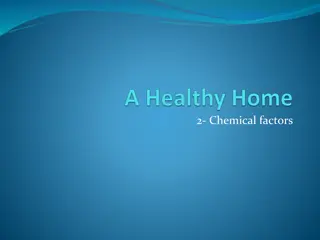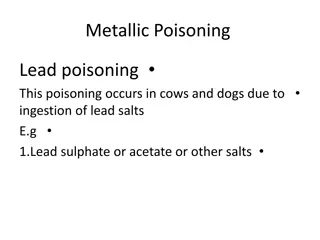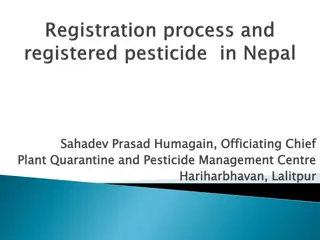Organochlorine Pesticide Poisoning in Animals
Organochlorines are synthetic pesticides with high toxicity and slow degradation, posing a threat to both target and non-target species. Despite bans in developed countries, their use persists, leading to environmental persistence and bioaccumulation. Natural sources also contribute to organochlorine pollution. Mechanisms of action, examples, and effects on the central nervous system in animals are detailed in this informative piece.
Download Presentation

Please find below an Image/Link to download the presentation.
The content on the website is provided AS IS for your information and personal use only. It may not be sold, licensed, or shared on other websites without obtaining consent from the author.If you encounter any issues during the download, it is possible that the publisher has removed the file from their server.
You are allowed to download the files provided on this website for personal or commercial use, subject to the condition that they are used lawfully. All files are the property of their respective owners.
The content on the website is provided AS IS for your information and personal use only. It may not be sold, licensed, or shared on other websites without obtaining consent from the author.
E N D
Presentation Transcript
ORGANOCHLORINE PESTICIDE POISONING IN ANIMALS VPP 609 Unit II 18/11/2020 Dr. Sanjiv Kumar, Assistant Professor, Department of Veterinary Pathology, BVC, Patna
Organochlorines (OC) are a group of chlorinated compounds widely used as synthetic pesticides. These chemicals belong to the class of persistent organic pollutants (POPs) with high persistence in the environment. These compounds are known for their high toxicity, slow degradation and bioaccumulation. Even though many of the compounds which belong to OC were banned in developed countries, the use of these agents has been rising. This concerns particularly abuse of these chemicals which is in practice across the continents. Though pesticides have been developed with the concept of target organism toxicity, often non- target species are affected badly by their application.
Natural occurrence Many organochlorine compounds have been isolated from natural sources ranging from bacteria to humans. Chlorinated organic compounds are found in nearly every class of biomolecules including alkaloids, terpenes, amino acids, flavonoids, steroids, and fatty acids. Organochlorides, including dioxins, are produced in the high temperature environment of forest fires, and dioxins have been found in the preserved ashes of lightning-ignited fires that predate synthetic dioxins.
Pesticides The two main groups of organochlorine insecticides are the DDT-type compounds and the chlorinated alicyclics. Their mechanism of action differs slightly. The DDT like compounds work on the peripheral nervous system. At the axon's sodium channel, they prevent gate closure after activation and membrane depolarization. Sodium ions leak through the nerve membrane and create a destabilizing negative "afterpotential" with hyperexcitability of the nerve. This leakage causes repeated discharges in the neuron either spontaneously or after a single stimulus.
Chlorinated cyclodienes include aldrin, dieldrin, endrin, heptachlor, chlordane and endosulfan. A 2- to 8-hour exposure leads to depressed central nervous system (CNS) activity, followed by hyperexcitability, tremors, and then seizures. The mechanism of action is the insecticide binding at the GABAsite in the gamma-Aminobutyric acid (GABA) chloride ionophore complex, which inhibits chloride flow into the nerve. Other examples include dicofol, mirex, kepone, and pentachlorophenol. These can be either hydrophilic or hydrophobic, depending on their molecular structure.
Examples Chemical names DDT, DDD, Dicofol, Eldrin, Dieldrin, Chlorobenziate, Lindane, BHC, Methoxychloro Organochlorines Aldrin, Chlordane, Heptaclor, Endosufan, Isodrin, Isobenzan, Toxaphene, Chloro propylate
Pesticides Toxicity LD50 Use Persistence in environment WHO classification based on rat oral LD50 Dichlorodiphenyltrichloro ethane (DDT) C14H9Cl5 Rat Acaricide Insecticide High Moderately hazardous Oral: 113 130 mg/kg Dermal: 2510 mg/kg Mice Oral: 150 300 mg/kg Gunia Pigs Oral: 300 mg/kg Rabbit Oral: 400 mg/kg Persistence Half life: 2 15 years
1,1-dichloro-2,2bis (p- chlorophenyl)ethane (DDD) Rat Insecticide High Acute hazard is unlikely Oral: 4000 mg/kg Persistence Half life: 5 10 years
Endrin C12H8Cl6O Rat Avicide insecticide Moderate Persistence Half life: 1Day to 12 Years Highly hazardous Oral: 3 mg/kg Dermal: 15 mg/kg Mouse Oral: 1.37g/kg Intravenous: 2300 g/kg Goat Oral: 50 mg/kg Rabbit Oral: 60 94 mg/kg
Methoxychlor C16H15Cl3O2 Rat Insecticide High Acute hazard is unlikely Oral: 5000 6000 mg/kg Mice Oral: 2000 mg/kg Monkey Oral: 2500 mg/kg Persistence Half life:< 120 Days
Lindane C6H6Cl6 Rat Acaricide Insecticide Rodenticide High Moderately hazardous Oral: 88 270 mg/kg Mouse Oral: 59 246 mg/kg Persistence Half life: 15 months
Aldrin C12H8Cl6 Oral: 39 to 60 mg/kg Dermal: 100 mg/kg Mouse Oral: 44 mg/kg Dog Oral: 65 95 mg/kg Insecticide Moderate Persistence Half life: 4 7 years Highly hazardous
Biochemical toxicity Organochlorine toxicity is mainly due to stimulation of the central nervous system. Cyclodines, such as the GABA antagonists endosulphan and lindane, inhibit the calcium ion influx and Ca- and Mg-ATPase causing release of neurotransmittors
Biochemical effects Sl.No Chemical name Organism Biochemical effects 1 Aldrin and Dieldrin Human Neurotoxic, reproductive, developmental,immunological, genotoxic, tumerogenic effects, nausea, vomiting, muscle twitching and aplastic anemia Mouse, rat, guniea pig, rabbit and dog Convulsions, loss in body weight, depression, increased irritability, salivation, hyperexitability, prostration and death 2 Chlordane Human Convulsions, tremor, mental confusion and incoordination Mice Reduced fertility, liver cancer
BHC/ DDE Human Cyst in hands, itching, psoriasis, eczema, leucoderma, skin rashes DDT Human Prickling sensation of the mouth, nausea, dizziness, confusion, headache, lethargy, incoordination, vomiting, fatigue, tremors in the extremities, anorexia, anemia, muscular weakness, hyperexcitability, anxiety, and nervous tension Mice Liver tumors, liver changes including hepatocellular hypertrophy, margination and formation of lipospheres. Birds Egg shell thinning
Lindane Human Damage human liver, kidney, neural and immune systems, and induces birth defects cancer, cause neurotoxicity, reproductive toxicity and hepatotoxicity Rats Alters gene expression of liver and hepatotoxicity Methoxychlor Rats Reduced fertility
Signs The organochlorines most commonly stimulate the CNS, and symptoms can range from paresthesias to seizures. With large exposures and severe toxicity, status epilepticus with respiratory failure and death can ensue. In addition, nonspecific neurologic symptoms such as nausea, vomiting, headaches, and dizziness can also be seen. Myoclonus, increased deep tendon reflexes and tremors are also reported following toxic exposures. Some of these agents can cause sudden seizures, without any prodromal symptoms. These include lindane, cyclodienes and toxaphene. These sudden seizures can happen from 1 to 6 hours post-exposure, and the effects can last for days in severe cases.
Diagnosis The nervous system manifestations, signs, and symptoms described above are the most common clinical effects demonstrable after acute exposure to these agents. The differential diagnosis of this presentation includes other causes of seizures such as CNS infection and proconvulsant toxins such as theophylline, amphetamine derivatives, cocaine, camphor, INH and tricyclic antidepressants. A noxious, turpentine-like odor is described with toxaphene. Endosulfan imparts the smell of rotten eggs due to its high sulfur content. Many of the organochlorine agents are radio-opaque, so a plain radiograph of the GI tract may be helpful in estimating the dose ingested in select cases where organochlorine oral exposure is suspected.
Definitive laboratory confirmation of the presence of organochlorines in the serum, urine or tissues can be done using gas chromatography, but this process typically takes days and is not useful in the acute management of these agents. Where lindane is suspected as a toxin, serum concentrations can help to guide management and prognosis. A level of 0.02 to 0.20 mg/L is indicative of a toxic exposure with higher levels at greater risk for seizures. It is important to note that specialized testing is not readily available so test results may be delayed for days to weeks after specimens are collected and sent; clinical signs and symptoms are therefore paramount for diagnosis and management of these ingestions.
Treatment No specific antidotes are available for organochlorine poisoning. Decontamination may be indicated to prevent continued absorption, as well as exposure. Close attention must be paid to the airway and respirations of any patients in whom organochlorine toxicity is suspected. Oral exposures are difficult to manage because the risk of seizures and subsequent CNS depression precludes the use of activated charcoal in many cases. However, in cases that present within an hour of ingestion and in which the patient is still asymptomatic, a dose of activated charcoal may help prevent absorption from the intestines and enhance elimination from the GI tract. The enteral use of resins or lipophilic compounds that can sequester the toxin in the GI tract. Cholestyramine and olestra (a non-absorbed fat substitute) have both been utilized for this purpose. Although these agents may theoretically enhance the elimination of organochlorines after chronic exposures, they have not been studied in acute poisonings.
When seizures occur from organochlorine compound toxicity they should be managed using standard care procedures for protecting the airway and maintaining oxygenation. General anticonvulsants such as benzodiazepines (with barbiturates or propofol as second line agents) should be used in cases of status epilepticus. It is important to monitor for and recognize the dysrhythmogenic effects of organochlorine agents. Instead of epinephrine as first line therapy, beta- adrenergic blocking agents and magnesium are administered initially.























